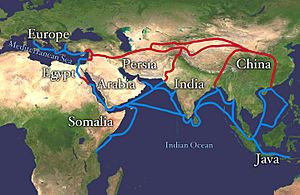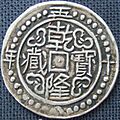History of the taka facts for kids

The taka (also called tanka or tangka) was a very important type of money in Asia a long time ago. It was used a lot in places like India, Pakistan, Bangladesh, and Tibet. This currency started in the 1300s and became popular along the Silk Road, which was a famous trade route. Its story is connected to the history of Islamic cultures in the Indian subcontinent.
Today, the Bangladeshi taka is seen as a modern version of this old currency. This is because the Bengal region (now mostly Bangladesh) was a key place where the taka was used. The old taka coins had writing in many languages, like Sanskrit, Arabic, Persian, Bengali, Nepali, and Tibetan.
Contents
Where the Name Taka Comes From

The word taka comes from an old Sanskrit word, tankah. Sanskrit is a very old language from India.
How Taka Started in North India
The imperial tanka was officially introduced by Muhammad bin Tughluq, the emperor of the Delhi Sultanate, in 1329. He made big changes to the money system. This new money was like "representative money." This means its value was based on gold and silver kept in the government's treasury. This idea was first used with paper money by the Mongols in China and Persia.
At first, the tanka coins were made from copper and brass. They were introduced because there wasn't enough gold and silver for coins. Later, silver tanka coins were also made. However, there was a lot of confusion when it first started, which caused problems for the Tughluq dynasty. After them, many smaller kingdoms appeared, like the Bengal Sultanate. These new kingdoms kept making taka coins with their own rulers' names on them. Even later, under the Mughal Empire, people still called local money "tanka" or "taka."
Taka in Arakan
The Bengal taka was used a lot in the Kingdom of Mrauk U (which is now in Myanmar) during the 1500s and 1600s. At that time, this kingdom was like a smaller state under the Bengal Sultanate.
Taka in Bangladesh Today
The Bangladeshi taka is the official money of modern Bangladesh. It was started in 1972 by the Bangladesh Bank. It replaced the Pakistani rupee after Bangladesh became independent. The Security Printing Corporation in Bangladesh makes these notes and coins. The Bangladeshi taka has special symbols: ৳ and Tk.
Taka in Bengal
In the past, one taka coin in Islamic Bengal was usually worth one silver rupee. In 1338, a traveler named Ibn Battuta noticed that the silver taka was the most popular money there, not the Islamic dinar. In 1415, explorers from Admiral Zheng He's group also saw how important the taka was. For the Sultan of Bengal, having their own taka coins was a big sign of their power. The Bengal Sultanate had at least 27 places where they made coins (called mints) across their kingdom.
The taka continued to be used in Mughal Bengal, which took over from the sultanate. As Bengal became richer and more connected to the world, the taka became the main official money. It replaced older forms of money, like shells, even in the countryside. It was also used for trade with European companies like the Dutch East India Company and the British East India Company.
-
A silver taka coin of Raja Ganesha with Bengali writing.
-
A silver taka coin of Jalaluddin Muhammad Shah with Arabic writing and a lion.
Taka in East India
In the 1300s, in a region called Odisha, old records mention types of taka like vendi-tanka (silver mixed with other metals) and sasukani-tanka (pure metal). The taka spread to this area from the Delhi Sultanate.
Taka in Nepal
The taka coin system came to the rich Kathmandu Valley in Nepal during the 1500s. It was based on the money used in Delhi, Bengal, and the Mughal Empire. The Nepalese tanka was a silver coin that weighed about 10 grams. King Indra Simha introduced it.
Taka in Pakistan
Before 1971, the money used in what is now Pakistan had writing in both Urdu and Bengali. It was called both the rupee and the taka. The Bengali Language Movement helped make sure the taka was recognized in East Pakistan (which is now Bangladesh).
Taka in South India
The taka was made in many places in the Deccan region of South India. This included the Deccan sultanates and Mughal areas. For example, in one area, one Tanka-i-Barari was worth eight Delhi tankas.
Taka in Tibet
The Tibetan tangka was the official money of Tibet for 300 years. It was brought there by merchants from Nepal in the 1500s. These merchants used Nepalese tanka coins on the Silk Road. The Tibetan government started making its own tangka coins in the 1700s. The first Tibetan tangka was made in 1763 or 1764. China's Qing dynasty, which had influence over Tibet, also set up mints there in 1792. These Sino-Tibetan tangka coins had Chinese language writing on them.
Paper money was also printed between 1912 and 1941. These banknotes came in values like 5, 10, 15, 25, and 50 tangka.
-
A Tibetan tangka coin made by the Qing dynasty.
Taka in West India
In the 1400s, the Gujarat Sultanate on the west coast of India started making silver taka coins. This was a way for the Muzaffarid dynasty of Gujarat to show their power.
See also











